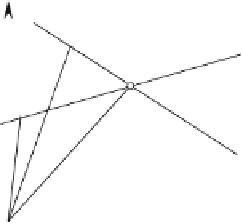Graphics Reference
In-Depth Information
To begin with, we must anticipate all the possibilities that could arise with two lines: the
first is that the lines do intersect, giving a single point of intersection; second, the lines could
be coincident, producing an infinite number of intersections; and third, the lines are distinct,
but parallel, producing no intersections. Although one can approach this problem using line
equations, we consider only a vector approach.
Y
S
a
P
b
R
s
r
p
X
Figure 3.33.
The lines are shown in Fig. 3.33 and are defined as follows:
p
=
r
+
a
p
=
s
+
b
where and are scalars, and the direction vectors are
=
+
a
x
a
i
y
a
j
b
=
x
b
i
+
y
b
j
The task now is to discover the values of and at the point P. Let P x
P
y
P
be the point of
intersection of the two lines and
p
its position vector. Therefore,
r
+
a
=
s
+
b
(3.66)
In order to isolate , we multiply Eq. (3.71) by
b
⊥
:
b
⊥
·
b
⊥
·
b
⊥
·
a
=
s
−
r
+
b
and as
b
⊥
·
b
=
0,
b
⊥
·
s
−
r
=
b
⊥
·
a
from which we can state that
x
b
y
S
−
y
R
−
y
b
x
S
−
x
R
=
x
b
y
a
−
x
a
y
b














